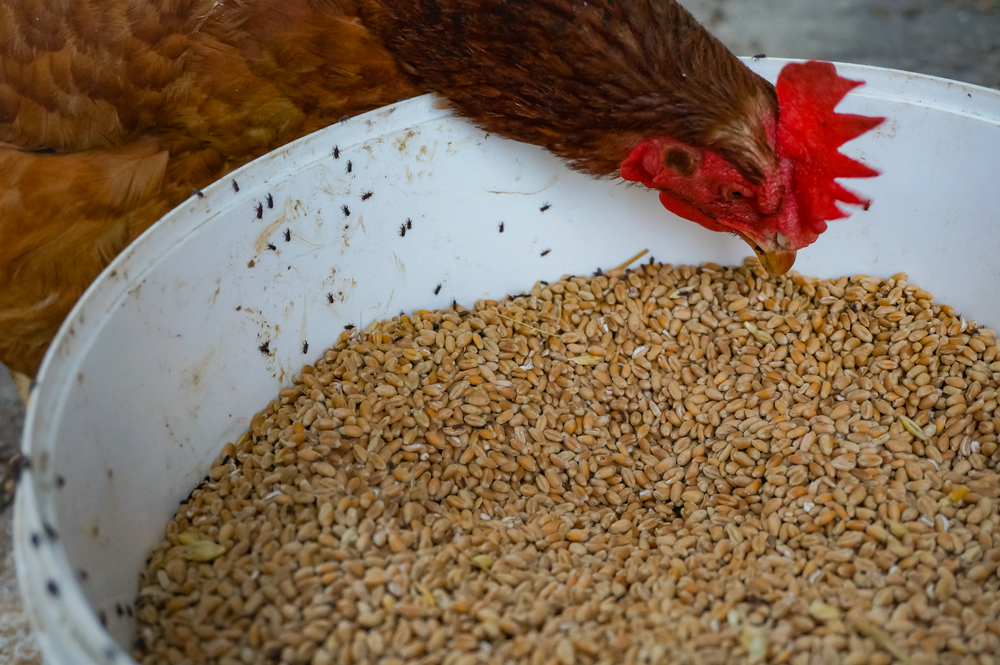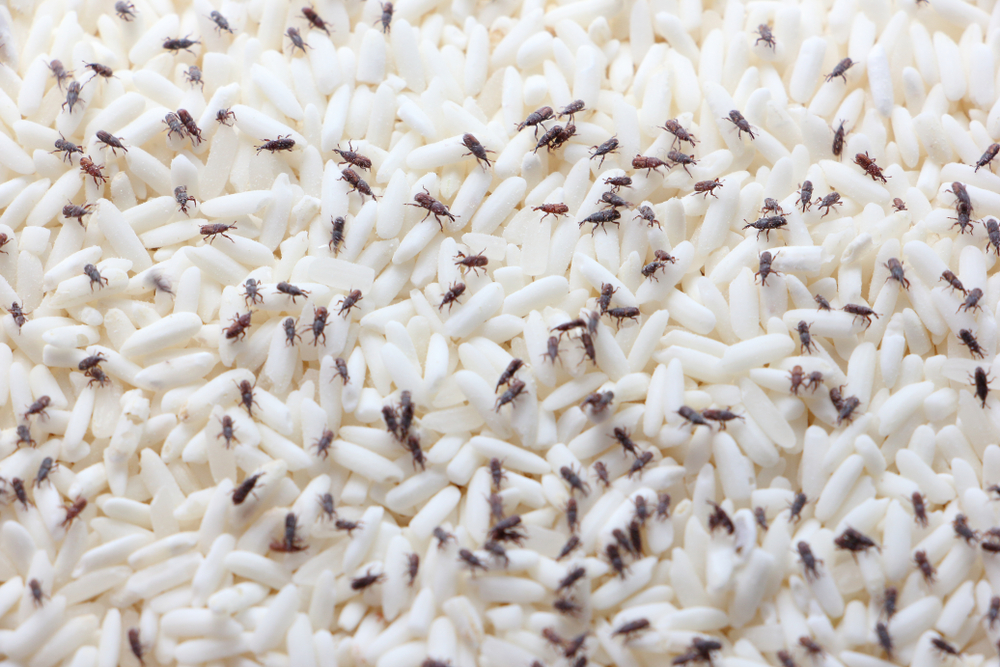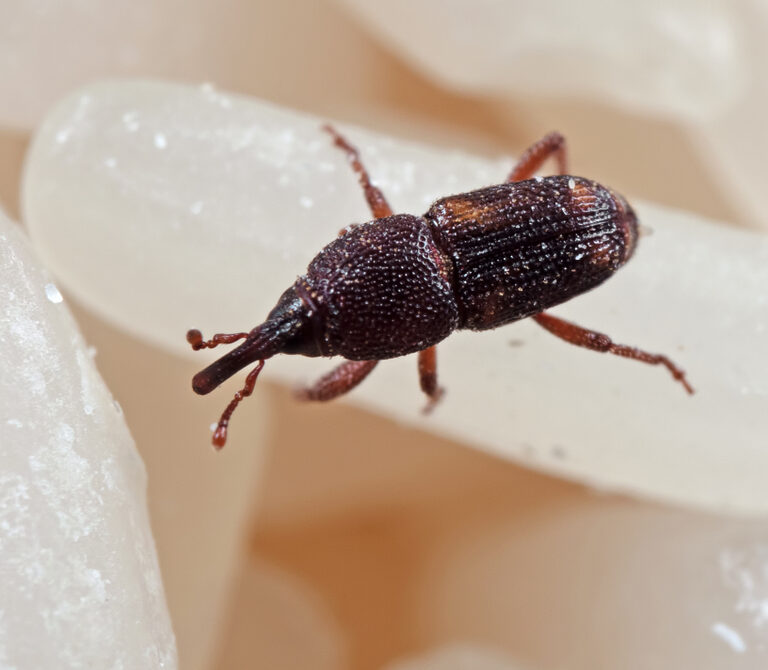Weevils are notorious pests that affect food supply chains and pantries worldwide. They’re part of what is known as “stored product insects” (SPI), a group of pests that mainly feast on dried goods. Unlike other types of pests, weevils come inside the packages of food we buy at the market, making them hard to prevent.
You may see one moving along your pantry and think nothing of it, but their populations can grow large at an alarming rate. If they have become a problem in your household, then this is the guide for you. Here’s how to get rid of weevils.
Best Way to Get Rid of Weevils
1. Inspect Your Pantry
The first thing you need to do is survey the extent of the damage and find the source of the infestation, which is more than likely a bag of dried food. Take note of all the places they seem to be moving towards, especially if they’re getting into any cracks or crevasses.
2. Throw the Food Away
The thing about weevils is that, unlike other dried food pests like pantry moths, it’s quite hard to know which products are infested and which ones aren’t, because they are tiny bugs and their larvae are hidden inside the grains.
Sadly, because of this, the best way to make sure that there are no remaining weevils is to throw away all of your stored food. It may sound like a blow to your budget, but consider that if you don’t do this, there’s a chance that they will infest your food again and again.
3. Clean the Pantry
What You’ll Need
- A vacuum
- Rags or paper towels
- A bucket full of fresh water
- Toothpicks
Use a vacuum cleaner to take care of any crumbs or weevils that are still around after you have taken the food out. Make sure you cover every corner of the pantry area, especially spots where food crumbs may have fallen. Pay extra attention to any cracks or holes where they may have wandered.
Next, use paper towels or a clean rag with water to wipe down every surface inside and in close proximity to your pantry. Avoid using any cleaning products because, while it may repel weevils for a little while, it makes the next step of applying insecticide less effective in the long term.
Use a toothpick to clear out anything that is inside cracks or crevasses inside your pantry. Any crack or hole serves as prime real estate for an ambitious weevil. Your pantry doesn’t need to be sparkling, but clean enough that there’s no dust or crumbs on top of its surfaces.

4. Apply Insecticide
In the early stages of an infestation, throwing out a bag of compromised food might be enough. However, when you start seeing weevils running outside of the food container, then it’s time to use something more serious.
The most recommended pesticides for weevil infestations are either permethrin or bifenthrin. They are both widely available under different brand names. For this reason, there’s no single correct method to apply them. Instead, you should always follow instructions on the product’s label.
Once you’re done applying the insecticide, leave your pantry open for two days or so before restocking it again with food. This way you can monitor if there are still weevils inside.
5. Set Up Traps
There are many store-bought pantry pest traps that you can set up to take care of any stubborn weevils. Alternatively, if you want a more natural alternative, bay leaves and cloves are natural weevil repellents that you can use. Make sure you set them up inside your pantry, but never rely just on them to take care of the problem, as they’re not a preventive method.
How to Prevent Weevil Infestations
There’s not a 100% successful way to prevent weevils from entering you home since they most likely come from the grocery store. Even at the store, they’re hard to identify because their larvae live inside the food grains. The best way to prevent an infestation is to make sure they can’t spread easily between bags of food inside your pantry. Make sure to follow these tips to keep your food free from weevils and other pantry pests:
- Always keep your food stored inside thick and sealed plastic containers.
- Seal any cracks that weevils or other insects may use in your pantry and kitchen.
- Clean your pantry and containers regularly and make sure there are no crumbs laying around on your counters or inside your pantry.
- Do not mix new and old food in the same container.
- If you’re unsure about a certain item being infested, put it inside the freezer for a few days.
- Always inspect food packages at the store. If you find a hole in a bag, that’s a point of entry or a sign that something probably made its way inside.
- Try to not overstock your pantry with food. If you can buy grains every two weeks or so, that’s better. The longer a bag of dry food stays in your pantry, the more likely it is to develop a pantry pest.

FAQ About Weevil Infestations
How to Identify Weevils
Identifying them is essential, because you don’t want to buy the wrong eradication method by confusing them with other kinds of pests. Luckily, weevils are very distinctive, if you manage to get a close look at one.
They are very small, typically 1/16 to 1/8 inch long. There are many types of weevils, but the ones that terrorize pantries tend to be brown or black. They have very long snouts, like tapirs, and can look somewhat goofy.
You can’t usually spot the larvae, because weevils lay their eggs inside grains, where they form a cocoon. You can usually just see the adults, because that’s when they emerge from our precious food.
While they’re more common inside pantries, weevils also enjoy eating cotton fabric and plants. That’s why it’s important to start eradication as soon as possible. Since they can fly, it’s very easy for them to expand to other areas of the house and you don’t want that.
Unlike other types of pests, weevils are not something you get from lack of cleaning or anything you did. They tend to show up in products we buy from the store. They are common in warehouses where lots of foods are stored.
Do Weevils Pose a Threat to Humans?
No, they are harmless, even if you accidentally eat them. There’s a dad joke somewhere in there about eating more protein, but the reality is it’s more disgusting than it is dangerous. While they’re not the cleanest thing you’ll ever eat per se, these insects generally hatch and spend their whole lives inside bags of food, which makes them generally safe, should any accident happen.
Final Thoughts
Rest assured that a weevil infestation looks worse than it really is. Taking the necessary steps to keep your food stores free from pests is more about consistency with cleaning and product separation than anything else. Remember that they’re not a sign that you’re doing something wrong, because these little travelers have probably made their way across the world inside supply chains.
